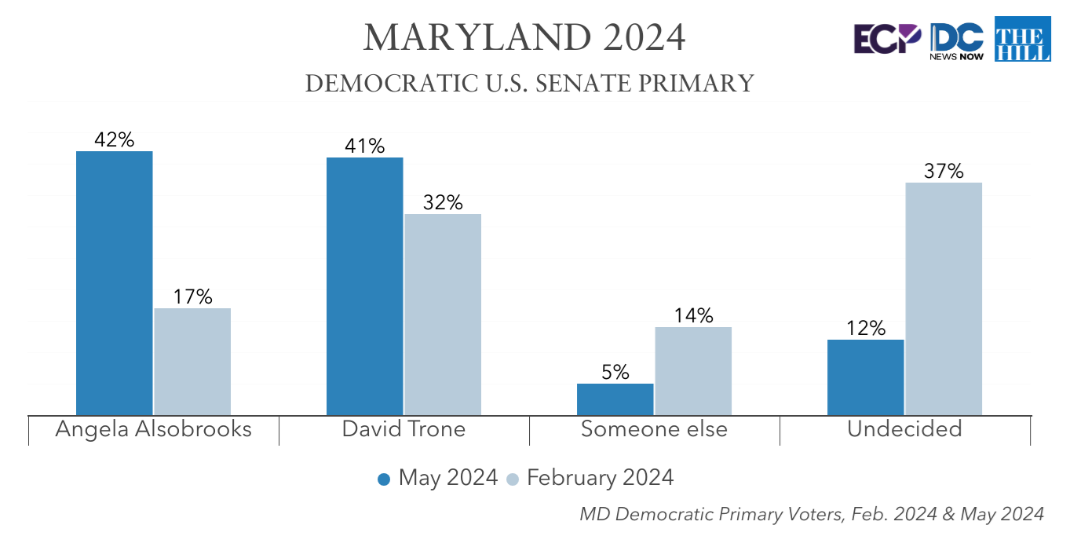By Adam Pagnucco.
Last month, I wrote a column titled “Is Alsobrooks Closing the Gap?” That column discussed a poll by Prince George’s County Executive Angela Alsobrooks’s pollster, Garin-Hart-Yang, showing that she trailed Congressman David Trone by 3 points after several polls showing much larger Trone leads. That 3 point lead was within the poll’s margin of error (+/-4), meaning that the race was statistically tied. The poll was conducted almost two months after Alsobrooks went up on TV. (Trone has been on TV for a year with a short break last summer.)
Consider some key events since then.
Alsobrooks’s Q1 campaign finance reports showed a solid performance that was not far off from what Chris Van Hollen raised for Senate in the 2016 cycle. That’s nowhere near Trone’s self-funding but it is enough to get her message out.
Trone started running a negative TV ad against Alsobrooks in late April. Candidates with big leads generally don’t go negative.
A stressed out Trone lashed out at a Fox 5 reporter over coverage of his statements on public safety.
Trone released internal polls showing big leads over Alsobrooks in December and January. He has not released any internal polls since then.
Do you see a pattern here, readers?
Now we have a brand new poll by Emerson College Polling/The Hill/DC News Now finding a one-point lead for Alsobrooks, adding further evidence to the story of Alsobrooks’s comeback. Here is the poll’s methodology statement:
The Emerson College Polling/The Hill Maryland poll was conducted May 6-8, 2024. The sample consisted of n=1,115 Maryland registered voters and with a credibility interval, similar to a poll’s margin of error of +/- 2.9 percentage points. The Democratic Primary consisted of n=462, with a credibility interval of +/-4.5%. The Republican Primary consisted of n=248, with a credibility interval of +/-6.2%. The data sets were weighted by gender, age, party registration, race, and education based on US Census parameters, and Maryland voter registration and voter turnout data by regions (MD SOS). Data was collected by contacting a list of cell phones via MMS-to-web and landlines via Interactive Voice Response (IVR), provided by Aristotle, and an online panel provided by CINT.
Here are a few findings of interest.
Alsobrooks led Trone in the Democratic primary by 42-41% with 12% undecided. The graphic below shows how this compares to a poll the same organization did in February, when it found a 15-point lead for Trone.

Undecided Democratic voters lean to Alsobrooks by 40-29%. When leans are added in, Alsobrooks leads Trone by 47-44%. Note that the margin of error is +/-4.5 points for Democrats.
Among Democrats who said they were “very likely” to vote in the primary, 47% picked Alsobrooks and 42% picked Trone.
Among Democrats who said they had already voted, 51% voted for Trone and 45% voted for Alsobrooks. (I wonder how many of these people voted before the Washington Post endorsed Alsobrooks on April 18.)
Trone leads 48-35% among White Democrats and Alsobrooks leads 56-28% among Black Democrats. Trone leads 45-41% among men and Alsobrooks leads 43-38% among women. No geographic information is available. (Dang!)
In the general election, Trone leads Hogan by 49-38%. Back in February, Hogan was tied with Trone at 42%.
Also in the general election, Alsobrooks leads Hogan by 48-38%, almost the same margin as Trone. Back in February, Hogan led Alsobrooks by 44-37%. This damages Trone’s narrative that he is the only Democrat who can beat Hogan.
The top three issues for all voters are the economy (31%), crime (17%) and housing affordability (12%). The top three issues for Democrats are the economy (24%), crime (17%) and threats to democracy (16%), with housing affordability a close fourth (15%).
So let’s connect all these dots. The April Garin-Hart-Yang poll. Alsobrooks’s able fundraising and her presence on TV since February. Trone going negative, chewing out a TV reporter and not releasing any internal polls for months. And now this poll.
Trone’s big lead appears to have evaporated. Whoever wins, the Democratic primary looks headed to a tight finish. Hogan and national GOP money await the victor.
